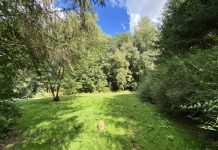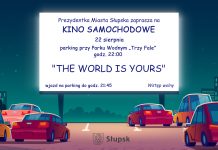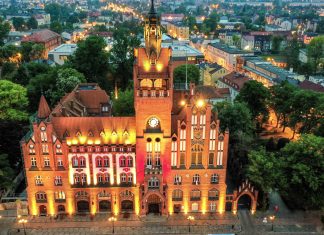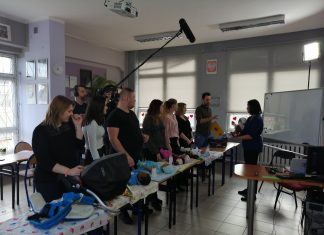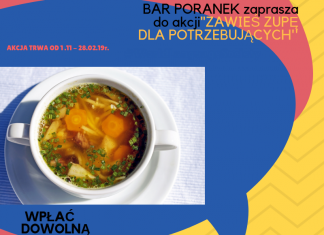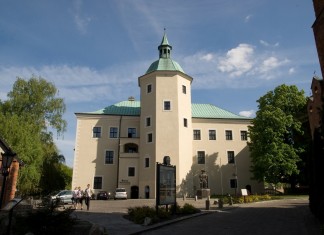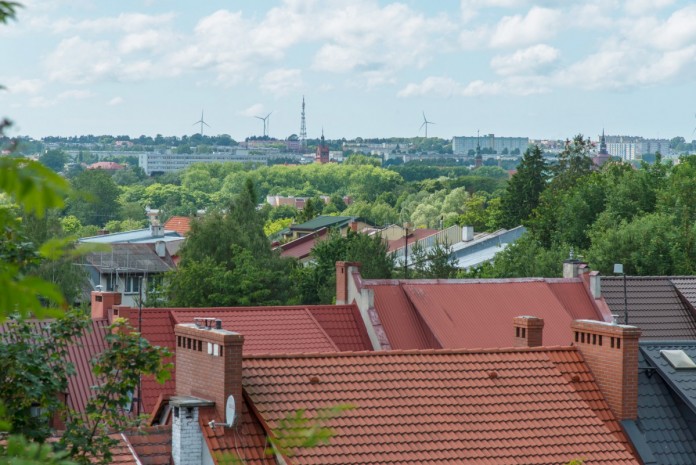
We suggest starting your stroll around Słupsk from the City Hall and the observation terrace of the City Hall tower overlooking the panorama of the eastern part of the city. The City Hall was constructed in 1899-1901, in the formerly popular Neo-Gothic style. It is one of the showcases of Słupsk. At the staircase, by the main entrance you will see wall paintings depicting the Fish Market in Słupsk, and unloading goods at the commercial harbour in Ustka. In the hall on the first floor there is a showcase which exhibits a symbolic Key to the United Europe, granted to Słupsk in May 2004. Another showcase presents a replica of the Bear of Happiness, an amber figure dating back to the Stone Age, found in Słupsk neighbourhood in 1887. According to historians, it might have been a bear hunter’s amulet. Also on the first floor there is the mayor’s office, with the total of 12 walls. Attention should be drawn to the original, more than one hundred-year-old wallpapers, desk and stained glass as well as gas chandelier converted into an electrical one. The mayor himself may usually be encountered in the City Hall bar (low ground floor) around 2.00 pm.
The City Council meetings and other important ceremonies are held in elegant room no. 211 on the second floor. Two paintings on the wall attract attention: an allegorical painting depicting the moment of granting municipal rights to Słupsk in 1310, and a scene depicting city liberation by its citizens from the Teutonic power.
Entrance to the City Hall tower
In season: Mon-Fri at 10.00 am – 5.00 pm, weekends at 10.00 am – 2.30 pm. Out of season: Mon-Fri at 9.30 am – 3.30 pm, Sat at 10.00 am – 2.00 pm (every full hour). Admission: PLN 3 normal, PLN 2 reduced (pupils, students, pensioners, disability pensioners), children under four – free of charge.
On leaving the City Hall we are facing the Zwycięstwa Square. We are going to Jerzy Waldorff Park situated opposite the Zwycięstwa Square. Along the park, on the left there are remnants of the mediaeval city walls. On the right, on the way from the City Hall we can see the New Theatre (repertoire: www.nowyteatr.pl) and Polish Philharmonic Sinfonia Baltica (www.filharmonia.sinfoniabaltica.pl).
Leaving the park, turn left towards the church. This is St Jack’s Church dating back to the 15th c., with a Renaissance altar and baroque organ. In summer organ music concerts are held in the church on each Thursday. Admission free. Musicians and singers from all over the world play concerts here. To check time and date of next concert please visit St Jack’s Church’s web site.
Behind St Jack’s Church there is the Castle of the Pomeranian Princes dating back to 1586, housing the Museum of Central Pomerania. Next to it there is a one-storey castle mill with a sloping roof. There are many interesting exhibitions in the Museum, e.g. relics of material culture connected with the history of the Pomerania, everyday life of the inhabitants, former art of the Pomerania, treasures of the Griffins, the Pomeranian Princes and others. A special exhibition is devoted to the history of Słupsk. The Museum prides the greatest collection of works by Stanisław Ignacy Witkiewicz (Witkacy) in Poland, covering more than 250 paintings and drawings. The permanent exhibition includes around 120 paintings which are partly exchanged every several months.
Visit the castle and the mill
The Museum of Central Pomerania in Słupsk is open: in season from 1st July until 15th September
on Monday at 10.00 am – 3.00 pm, Tuesday – Sunday at 10.00 am – 6.00 pm. Out of season: Wednesday-Sunday at 10.00 am – 4.00 pm (Monday, Tuesday – closed). You may visit permanent exhibitions of the Museum free of charge on Saturdays. Works by Witkacy are available on the second floor. Normal ticket PLN 12, reduced (pupils, students, pensioners) PLN 8, a ticket to the castle tower PLN 2, reduced PLN 1.
Next to the castle (behind the small bridge) there is the Mill Gate dating back to the 14th c., which led to the city from Gdańsk. Next to the gate there is the Fishermen’s Market, a square with Richter’s Granary moved to this place beam by beam from Kopernika Street. Fish and pottery markets used to be held in the Fishermen’s Market. Similar Griffins’ Fairs are organised nowadays on each Sunday of July and August as open air events popular with the inhabitants and tourists.
Coming back from the Fishermen’s Market we go along the bridge and behind it we turn right towards the river. We go to Rev. Jerzy Popiełuszko Boulevard, running along the Słupia River liked by and popular with anglers due to the occurrence of sea trout in this area. We recommend rafting down the Słupia River within Słupsk – Ustka section. Several entrepreneurs offer kayak rental and organised rafting. All you have to do is enter term „kayaks Słupia” into an Internet browser.
Along Popiełuszko Boulevard run the remnants of the city walls, as well as the Witches’ Tower, the only preserved fortified tower originating from the 15th century. Its name is not coincidental. In the 17th c. the tower performed the function of a prison for women accused of witchcraft. That is why the weathercock at its top is shaped as a witch on a broom. It is there that women were tortured, tried, sentenced and burned on stake. The first witch trial took place in 1651, and the last in 1714. 18 women were executed within that time. Today the tower houses one of the branches of the Baltic Gallery of Contemporary Art where painting, sculpture, photography and spatial installation exhibitions are held.
Exhibitions at the Baltic Gallery of Contemporary Art
www.bgsw.pl
„The Red Poppy Fields” – international exhibition by Andras Boszo (HU), diSTRUKTURA (SR), Lara Chiarabellini (IT), Radenko Milak & Roman Uranjek (BiH / SI), Ernst Friedrich (DE), Borut Peterlin (SI), Darije Petković (CR), Karoly Sandor Aron (HU), Svatopluk Mikyta (SK) and more (TBA)
27th April – 17th June, the Cameral Gallery at 31 Partyzantów Street and The Witches’ Tower.Apologia przypadkowości by Odo Marquard 8th July – 30th September,
the Cameral Gallery at 31 Partyzantów Street and The Witches’ Tower.The Cameral Gallery is open on weekdays (Mon-Fri at 9 am – 5 pm). The Witches’ Tower is open every day except Mondays at 9 am – 5 pm. In July and August tickets are obligatory. Admission to one gallery: normal ticket PLN 6, reduced PLN 4, collective PLN 3 (groups of min. 10 people). Admission tickets to both galleries: normal PLN 8, reduced PLN 6, collective PLN 4 (groups of min. 10 people).
Going along the boulevard by the river we reach the Kowalski Bridge. On the right behind the River there is the poviat governor’s office building with its characteristic quadrilateral tower. There is the Old Market Square on the left. We turn towards the governor’s office building into Szarych Szeregów Street. The building was erected in 1903 of red brick, in the eclectic style (combining various architectural styles). From the beginning of its existence the office building housed the country district authorities.
The Powstańców Warszawskich Park is situated behind the governor’s office in Szarych Szeregów Street. In the Park there is a monument dedicated to insurgents, the first monument in their memory that has ever been built in Poland. It was erected in September 1945 on the initiative of former Warsaw citizens who came here to settle after the war. According to some messages, a few bricks of the monument come from the ruins of destroyed Warsaw.
Crossing the Powstańców Warszawskich Park diagonally we will go into Partyzantów Street. On the right there is the Baltic Gallery of Contemporary Art. Farther on there is a junction with Jana Kilińskiego Street. In front of us there is the gate of the Police School in Słupsk.
We turn right at the junction of Partyzantów and Kilińskiego Streets. A cemetery situated at the level of the junction with Żwirki i Wigury Street, under the street, pavement and buildings was established during the Thirty Years’ War (1618-1648). It was the burial place of the victims of a plague the city faced. We reach the junction of Kilińskiego and Kaszubska Streets. There is the municipal cemetery on a hill in front of us. On the left there is a complex of the old Słupsk brewery buildings dating back to the 2nd half of the 19th c. Before World War II it was one of the biggest breweries in the Pomerania referred to as the starry brewery. It was there that beer “Stern” (Germ. word for “a star”) popular in Germany at that time was produced. After the war the beer was brewed here until the early 21st c. At present the buildings are privately owned, however, visitors may enter into the brewery courtyard and watch the interesting industrial architecture of that period. There is no brewery in the city now, even though in the past it was famous for brewing. In the 16th c. the city brewers gained exclusive rights to beer trade in the Pomerania. Around 200 small breweries operated in the city in the 17th c. Moreover, the citizens brewed their own beer. Homemade beer production started to disappear gradually in the mid-19th c. Also minor breweries collapsed, despite the support by big ones who dealt with industrial beer production. Around 1815 there were still almost 25 breweries in Słupsk, but only 8 were left before World War II.
Now we turn left into Kaszubska Street and reach the junction (roundabout) of Kaszubska, Kościuszki (on the left) and Madalińskiego Streets (on the right). In Madalińskiego Street there is the 650-lecia Stadium. Behind the Stadium there is the Northern Wood, a sports and recreation area with avenues, running and health paths, and horse riding trails, as well as a ropes course. Yet we turn left into Kościuszki Street with its municipal pond. At the end of the street, on the left there is the big, red brick pre-war girls’ school building. Today it houses the lecture halls of the Police School. We cross the river and get to the roundabout-junction of Kościuszki and Bałtycka (right), Poniatowskiego (straight) and Kopernika (left) Streets. We turn left into the park in Kopernika Street. On the right we can see the former hospital buildings complex made of red brick.
At the end of the park in Kopernika Street we turn right and reach the former Agricultural Department Store. Further on we get to the junction (rondo) of Kopernika and Grodzka (straight) Streets, Kilińskiego (left) Street and Sienkiewicza (right) Avenue to see another municipal park. We go straight into Grodzka Street. On our left there is former St Nicolas Church dating back to the 13th c., which houses Maria Dąbrowska Municipal Public Library. Going down Grodzka Street we reach the Old Market Square. Its image from before the war is depicted in the photograph in the Market Square. The former Milenium Cinema operating in 1963-2010 constitutes the northern frontage of the Market Square. Founded as the most modern one in Poland, with a panoramic screen, providing seats for more than 700 people, it was extremely popular with both the inhabitants and visitors.
But the cinemas in Słupsk have not perished yet
The Milenium Cinema disappeared, but there are two more cinemas in Słupsk – the Multikino in Galeria Jantar shopping centre at 58 Szczecińska Street (www.multikino.pl) and the Rejs Cinema at the Youth Cultural Centre at 22 3 Maja Street (www.emcek.pl).
From the Old Market Square we go into Nowobramska Street. On the left we can see mediaeval Blessed Virgin Mary Church from the 13th c., with its baroque cupola reconstructed thanks to donations from Słupsk citizens and other donors in 2004. The tower leans from vertical by 89 cm. The curvature of the tower is best visible with the naked eye from Mikołajska Street, when we stand by the post office building from 1879.
In Nowobramska Street you can rest in Kafeina Café, Orient Café or Góra Lodowa Confectionery. At the end of the street there is the New Gate from the turn of the 14th and 15th c., which led to the city from Szczecin. In front of the gate there is a tram, a relic of the trams of Słupsk, which ran around the city in 1910-1959.
Turn right from Nowobramska into Filmowa Street and then left into a small square, go past the fountain and further in through the passage under Anny Łajming Street. We are in the Pierwszych Słupszczan Square. In front of us there is Galeria Podkowa Shopping Centre; we turn right into Wojska Polskiego Street running to the railway and bus station. It was in 1869 that Słupsk gained the connection with the rest of the world via railway. The station was situated beyond the city at that time. Present day Wojska Polskiego Street leading to the railway station was constructed later as a representative area leading to the city centre.
Let us stray from the path a little and turn into a narrow street behind tenement house no. 6 in Wojska Polskiego Street. We will go into the yard at Rondo Theatrical Centre and Słupsk Centre for Non-governmental Organisations and Social Economy (SCOPiES; both situated in Niedziałkowskiego Street). This is the site of the former synagogue burnt at the Night of Broken Glass in November 1938. It is commemorated by the plaque placed on the reconstructed brick fence. Looking around carefully you will notice a weird, around 6 metres’ high rusty pipe at the top of which birds sit time and again. This is a water feeder created probably in the first half of the 20th c. Thanks to natural pressure it is always full of water. Going into the courtyard in front of the Theatre and the SCOPiES, we turn left into the narrow avenue between the Theatre and the tenement house in Niedziałkowskiego Street (we don’t go into the Street). We are going out to the Cultural Yard with a stage, playground, open-air gym and table-tennis area. We pass the Yard and turn left towards the tenements in Wojska Polskiego Street, pass the ceramic studio at Słupsk Cultural Centre (on the left) and go into Wojska Polskiego Street again through the gate of tenement house no. 10.
On the other side of the street you can spot the first pizzeria in Poland (47 Wojska Polskiego Street, at Poranek Milk Bar), founded in 1975. The pizzeria was founded by Tadeusz Szołdra, called the father of Słupsk gastronomy. During his visit in Italy he found the dish so delicious that he decided to make it in Słupsk. As no one could bake it at that time, it considerably differed from the original Italian pizza. It was smaller, its toppings and pastry were different, but huge number of people queued to taste it anyway. The first pizzeria was created at Poranek Milk Bar and has operated until present in a cosy room and unchanged interior design. It still enjoys great popularity among both Słupsk citizens and tourists. Price: PLN 5-6, depending on toppings. We finish our trip in front of the railway station constructed in 1991.
The guide compilation: Piotr Kawałek
Sources:
- www.piwomani.blogspot.com
- Piotr Kawałek Plażownik Środkowopomorski, Agora S.A., Warsaw 2011











